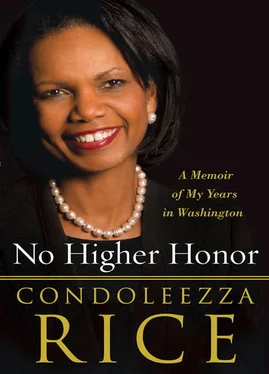I’ll never forget one such incident. At a meeting of ASEAN in Malaysia, I asked our hosts to convene a meeting of interested foreign ministers to talk about nuclear proliferation. The Six-Party Talks had stalled again, and I thought we might bring some international pressure on the Chinese and the North to move forward. My counterpart, Li Zhaoxing, had agreed to attend, but when the meeting started he was not present. We forged ahead, but there was a lot of mumbling that he’d stiffed the other participants—most especially me. About halfway through the meeting, Li appeared, visibly shaken. He said nothing. But when the session ended, he came up to me and apologized. “I’ve never been talked to that way!” he said, referring to his discussions with the North Koreans. He was quite furious and physically agitated. I later learned that he’d tried to bring the North Koreans to the meeting, only to be chewed out by the political commissar who was accompanying the hapless North Korean foreign minister. Sometimes even China couldn’t make Pyongyang budge.
Finally, in late August, the North Koreans began to push hard for a resolution to the terrorism list issue. They could count, and they knew we were several days past the forty-five days that had followed our notice to Congress. North Korea announced that it would be suspending its disablement of its nuclear facility in Yongbyon because the United States had not kept its end of the bargain. We decided that Chris should go to Pyongyang in search of a breakthrough, and he seemed to get one in early October. The parties agreed to verification measures that would give inspectors access to all declared sites related to the plutonium production program and, based on “mutual consent,” access to undeclared sites as well. As Chris noted at the time, we’d have to have consent anyway since we weren’t going to shoot our way into the facilities. The inspectors would also be able to carry out “scientific procedures” such as sampling and forensic activities—which were key to understanding what materials and chemicals were being used and thus the nature of the activities at any given site. Perhaps more important, the North Korean negotiator, Kim Kye Gwan, committed verbally to creating a separate document that would address outstanding issues—namely, North Korea’s suspected uranium enrichment program and allegations of proliferation.
The verification measures were far from perfect, and for eight days we debated whether to complete the process and remove the North from the state sponsors of terrorism list. Again the President faced contradictory advice, with the Vice President saying no and me arguing that we needed to take this one last step. The six parties would now work to put in writing what the North had committed to Chris verbally. The resulting verification protocol would have to be clear about what we were allowed to do because I wasn’t asking anyone to trust Pyongyang. But, I argued, we had no other way to get on the ground where we knew troubling activities were taking place. We’d obtained information about North Korea’s nuclear activities that had come from the approximately eighteen thousand pages of documentation that the North had handed over earlier that spring. These papers included operating records that dated back to 1986. The quid pro quo was worth a try, and anyway, removing the North from the terrorism list would have little if any effect on the sanctions we imposed on the regime. These measures had been codified in acts of Congress, executive orders, and UN Security Council resolutions that would remain intact. The United States wouldn’t make any additional concessions to the North without a satisfactory verification protocol. And if the North didn’t give us one, we would suspend the energy assistance that each of the six parties was scheduled to deliver as part of our previous agreements.
I thought I’d made a compelling argument. On the evening of October 9, I was at a State Department retreat just outside Washington, D.C. The President and I had talked numerous times about the decision he faced. At one point, he asked whether there was something else the North might accept. I asked Chris Hill the question. “They would accept a visit by you,” he answered.
I relayed the option to the President. “No! That would really legitimize him,” he responded, recalling the star-crossed trip to Pyongyang of Madeleine Albright, who had been made to endure a cultural event in which the citizens of North Korea carried out elaborate card displays.
That night, he called me several times, clearly struggling with the decision. I talked to Steve Hadley, who was also struggling, but he had decided he agreed with me on the decision. The President did too. I asked if the President wanted me to come back to Washington immediately. He did. I made my apologies to the State Department management and leadership and returned home. Knowing that the President had made the decision, I called several members of Congress. Most were fine, but some, such as Senators Jon Kyl and John Ensign as well as Congresswoman Ileana Ros-Lehtinen of Florida, were deeply troubled. Those were people whom I’d come to trust and respect, and it bothered me that they were so concerned.
I thought that the argument was solid for trying—one last time—to get the North Koreans to deal. That’s the way diplomacy works. But I knew that I’d asked the President to walk out on a limb and that if the North Koreans didn’t deliver he’d be subject to fierce criticism. That is, unfortunately, precisely what has come to pass.
Despite our best efforts, the North balked and would not write down the understandings we had agreed to orally. The final Six-Party Talks broke down on our watch on December 11. On December 12 we announced that we wouldn’t go forward on energy assistance absent progress on verification. We thought the Chinese and Russians had agreed, but they indicated that they would complete their share of energy assistance. South Korea, on the other hand, would not.
A month later, the North Koreans made a statement saying they wouldn’t allow nuclear inspections unless the United States’ “hostile policy and nuclear threat to the North are fundamentally terminated.” That was an old canard that Pyongyang employed when it didn’t intend to cooperate. The Six-Party Talks had come to an end.
Much later, in 2010, nuclear physicist Siegfried Hecker, a former director of Los Alamos National Laboratory, would be invited to North Korea and shown an industrial-scale facility capable of producing enriched uranium. According to Hecker, the state of the facility demonstrated “without a doubt” that Pyongyang had pursued uranium enrichment for many years. We’d been right about uranium enrichment but unable to use diplomacy to confirm our suspicions or do anything about it.
The fact is there are constraints in dealing with North Korea that limit the options available. In debates with the Vice President, I would often make that point and ask what option he was proposing. He could never come up with one that was actually feasible. Those discussions always demonstrated that there was no perfect solution to the problem.
The military option against Pyongyang was not a good one; it was fraught with unintended consequences and the near-certainty of significant damage to Seoul. Kim Jong-il maintains missile batteries whose projectiles can reach South Korea’s capital city in a very short period of time. Though august figures such as former Defense Secretary William Perry suggested we threaten to launch air strikes against the North’s ballistic missile site before their July 2006 test, President Bush and his advisors did not seriously consider military action. The Pentagon maintains military plans for war against North Korea. The day may come when a President has to use them, but everyone wants to avoid that outcome if at all possible.
Читать дальше












